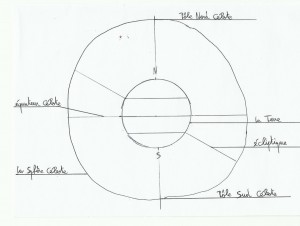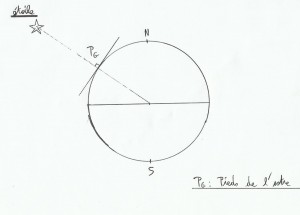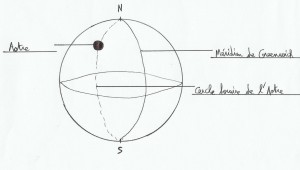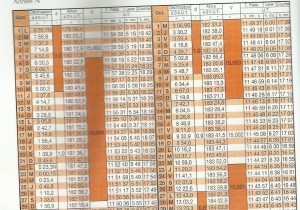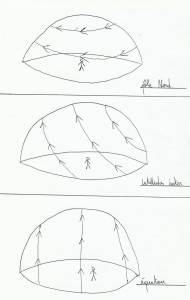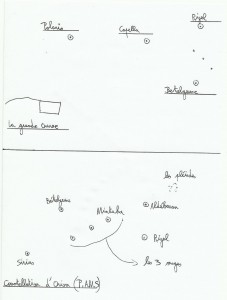In the old days the celestial vault was thought as a solid sphere where stars were hung on it, and that sphere turned around the earth which were inside like Russian dolls. We now know that this solid sphere does not exist, and celestial bodies motions in the sky from east to west are due to the earth's rotation on itself. We will still keep the idea of that sphere to locate ourselves in the sky.
1)Celestial lines
They correspond to lines placed on the globe, it's only their projection. The celestial equator is the projection in the sky of the earth's equator, for the celestial poles it's the same principle. The ecliptic on the celestial sphere is the apparent path of the sun in its annual course.
As we have seen in the short paragraph “position and orientation without gps or calculator”, the sun's path in a year varies between the Cancer and Capricorne's tropic about(23°26’N the 21 June, 23°26’S the 22 December). For an observer in Paris it means a higher sun on horizon in summer and lower in winter, the ecliptic is movable along the year and is the main cause of the seasons, shorter or longer days.
2)Landmarks used
Star's declination(star, sun…) corresponds to its latitude on the earth sphere. The right ascension corresponds to its longitude. These coordinates are taken from the foot of the star, intersection of the line which pass through the center of the earth and the sun, and the tangent to the sphere.
The declination ranges from 90 ° South to 90 ° north passing through the equator(O°). North values are preceded by a + and South values -. The right ascension runs along the celestial equator anticlockwise, it is counted in hours, minutes, seconds.
3)For navigation
For navigation, the term right ascension changes, we rather speak about hour angle. This is the angle between the meridian of origin(Greenwich)and the horary circle of the sun.
we find sun's celestial coordinates, moon's celestial coordinates, full of stars and planets coordinates in nautical almanachs. For all days and hours of the year we are able to know the position of a star.
4)Ephemeris
.The sun
it looks like this:
Ephemeris is based on the Greenwich time(U.T). The small letter d is the declination changes per hour, AHv0 is the hour angle of the sun at 0 hours U.T, V is the angular speed of the earth's rotation on itself relative to the sun( 15 °per hour is an average number), T pass is the passage time(U.T) of the sun at Greenwich meridian. Sund's declination given is at 0 hours U.T(we will call it D0).
D0 is positive from spring to autumn(because above the celestial equator)and negative from autumn to spring(because below the celestial equator). d is positive from spring to summer and from autumn to winter(because in these two cases D0 increases), and when D0 decreases d is negative(from summer to autumn and from winter to spring). AHvp angle is the sun's hour angle at the observation time, so it has to be calculated.
Knowing that, to know the position of the sun at the time of observation(t)we simply apply these formulas:
Declination = D0 d * t
AHvp=AHv0 V*t
Notice: when we are watching this ephemeris page we notice that declination is almost zero the 23 September, it's the autumnal equinox. at this moment the foot of the sun is on the celestial equator.
The rule of the four 21: at equinoxes(20 March, 23 September roughly), D0 = 0 roughly. at Solstices(21 June and 22 December roughly), D0 = 23 ° 26′ and -23 ° 26′ respectively.
.Stars
It's almost the same thing, but for the hour angle origin will change. This time the hour angle of the vernal point is used, its speed is constant and equal to 15 ° 2′,5. The vernal point is the intersection point between ecliptic and celestial equator, the point where the sun passes from south hemisphere to the north hemisphere(ascending node). The hour angle of the star relative to the Greenwich meridian is found by this way:
hour angle=AHGy AV
AHGy is the hour angle of the vernal point measured from the Greenwich meridian.
AV is the verse ascension of the star, measured from the vernal point to the West.
5)What is found on the celestial sphere
As we have seen in “position and locate yourself…” , according to the latitude where we are the celestial sphere will move differently. In the northern hemisphere the stars will rotate anticlockwise around Polaris, in the southern hemisphere clockwise around the south celestial pole identifiable with to the Southern Cross. At the poles stars follow parallels ways relative to horyzon and are circumpolar(do not rise, do not fall). At the equator the two celestial poles are on the horyzon and all the stars rise and fall. At intermediate latitudes some stars are circumpolar, other not.
For a star's declination D and an observer's latitude L:
(90°-L)<D, star visible all the night
D<-(90°-L), the star is not visible
-(90°-L)<D<(90°-L), the star is visible on a limited period(not circumpolar)
During the night, the ecliptic is noticeable with the twelve zodiacal's constellations( we can add up Ophiuchus actually thirteen in fact)and also with the solar system planets(because they are also included in the ecliptic plan). The zodiac constellations are Aries, Taurus, Gemini, Cancer, Lion, Libra, Virgin, Aquarius, Capricorn, Sagittarius, the Scorpion, Pisces. Visible planets are Venus, Mars and Jupiter.
The celestial equator can be identifiable through the constellation of Orion, Mintaka star(between the red giant Betelgeuse and blue giant Rigel) is located almost on the celestial equator.
P.A.M.S mean Pleiades, aldébaran, the 3 magi and Sirius because they are almost in line.
The stars sparkle, planets don't. The brightest star is Sirius in the constellation of the Great Dog. The brightest planet is Venus.
Planets: Venus and Jupiter are the brightest objects after the Sun and the Moon, they move compared with the rest of the background star. The planets move through the zodiac constellations. Venus is visible up to three hours before or after sunset(because the planet is close to him, Mercury is not visible because it is too close to the Sun). Venus is never higher than 46 ° relative to the horyzon.
